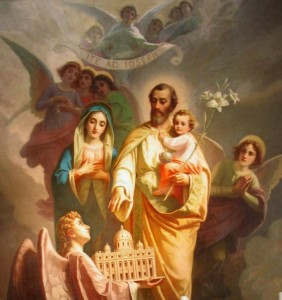 The Catholic devotion to Saint Joseph is strong and vital, and it is has been for centuries. You will see the phrase, “Ite ad Joseph” at the Saint Joseph shrine or altar. In fact, over the head of Joseph in this image you see the scroll with just that: Ite ad Joseph. The beloved spouse of Mary, since 1870, has been the Patron of the Church, named so by Pope Pius IX. In biblical typology of the OT Saint Joseph is prefigured by an earlier Joseph who is the protector of Israel.
The Catholic devotion to Saint Joseph is strong and vital, and it is has been for centuries. You will see the phrase, “Ite ad Joseph” at the Saint Joseph shrine or altar. In fact, over the head of Joseph in this image you see the scroll with just that: Ite ad Joseph. The beloved spouse of Mary, since 1870, has been the Patron of the Church, named so by Pope Pius IX. In biblical typology of the OT Saint Joseph is prefigured by an earlier Joseph who is the protector of Israel.
Pope Leo XIII in his 1889 encyclical, Quamquam pluries, speaks of Saint Joseph an “exemplary model of kindness and humility.” Such are the virtues that we expect all Christians to possess and develop: this is especially true for fathers, parents, priests, educators, and the like. As the spouse of Mary and earthly father of Jesus we come to understand Joseph as a “participator in her [Mary’s] sublime dignity.” Leo develops in a new way a theology of Joseph in looking at his chaste spousal relationship to Mary by describing him for us when he says that Joseph was “closer than any” other person.
Leo also designated Saint Joseph to be the universal patron of the Church.
One aspect of Saint Joseph that’s not well spoken of but was raised by Pope Leo is Joseph as protector, guide, patron of the priesthood of Jesus Christ. Considering biblical typology with regard to Joseph we see the Spouse of Mary as connected with, that is, echoing, Joseph of Egypt found earlier in the OT and as the earthly father of Jesus he is custodian of holiness. This man of righteousness we say exercised significant overseeing of Jesus is the “true bread come down from heaven.” Hence, Joseph’s role as guardian of the Holy Child, it is not unrealistic to consider as crucial to the life of both the ministerial AND lay priesthood. What is seen in Joseph is now seen in the our priestly life. Catholics distinguish the two priesthoods, one serving the other in a unique manner all oriented to salvation in Christ Jesus.
Just as Joseph attended to his family and daily work, he also was attentive to life of prayer and sacrifice given to him through the Torah (the Law of Moses). It is fitting to see these things held in creative tension but likely with an accent on prayer. All the things we say that Joseph could have done that would be opposite to having concern for Mary and Jesus were actually fulfilled because the Holy Spirit was such a powerful presence in Joseph. Without this Divine Presence Joseph would have collapsed under the weight of self-absorption. The intense friendship (that is, obedience) with the Divine Majesty allowed for his earthly love to taken on a new dynamism for all of history. One might say, like we ascribe to Mary, that Joseph was the second disciple of Jesus. Yet, he is the first to experience this discipleship in an unrepeatable way as being that close to the dignity of Mother and Son.
One last point of salvation history, Joseph is a fitting patron of the priesthood because he was the spouse of Mary, and that the report of Fatima is that he was with Mary then, leading up to these last days in the Lord.